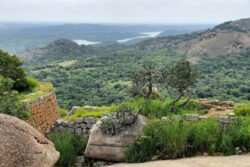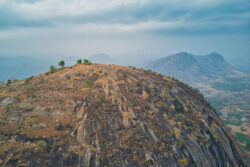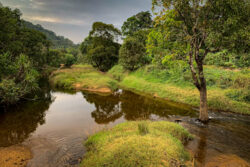When the stress of traffic in the city and the constant noise levels start to play havoc with my inner peace, the first getaway I always think of is a drive to the Cauvery Wildlife Sanctuary (CWLS). Situated at a distance of 90 kilometres from Bangalore, the drive to the sanctuary takes approximately two hours. Depart early from the city to escape morning traffic and you will be treated to scenes of farmers tending to their fields as you drive through rural landscapes and rustic villages.
As you leave Bangalore and head towards the town of Kanakapura, the altitude drops, and more so when you reach CWLS, which is at an altitude of 400 metres above MSL. Some parts of the drive do have an eerie resemblance to landscapes out of Africa – rolling plains with granite outcrops in the distance. These are vast areas of scrub jungle, home to plenty of wildlife.

The birding starts when you turn off from Kanakapura Road towards Sangama (confluence). As you drive past agricultural fields, bush-larks and shrikes can be seen perched on overhead wires. This stretch is the best place to see the endemic Large Grey Babblers as they fly noisily across the road with their ponderous tails hanging low. It isn’t uncommon to see harriers hunting over the fields and the occasional Tawny and Short-toed Eagles high in the sky. The calls of the Grey Francolin will announce their presence long before you see them.

A Yellow-eyed Babbler gathers grass to build a nest.
A forest gate marks the beginning of the sanctuary, and as you approach the river, the road slopes down into a couple of sharp hairpin bends. This is an excellent place to watch birds, since the activity levels are quite high, especially early in the morning. Minivets, woodpeckers, drongos, malkohas, ioras, and if you are lucky as I was, the White-naped Tit! The CWLS is also home to numerous mammals like elephants, boars, leopards, dholes, spotted and barking deer, Honey Badger, Grizzled Giant Squirrel and the Smooth-coated Otter. There are also recent reports of tigers within the sanctuary.

The roads to the CWLS are good and offer a very scenic drive.

A pair of White-naped Tits was feeding along with a mixed flock of other species and I was lucky to get a photograph of this rare bird.

The CWLS is a great place to see the Yellow-crowned Woodpecker.

A Blue-faced Malkoha grabs a caterpillar. Also known as the Green-billed Malkoha, these birds have a very characteristic blue eye ring.
You will eventually get to the river at Sangama, where the river Arkavathi joins the Cauvery and flows towards Mekedatu and the Tamil Nadu border. An island at the Sangama is home to a nesting colony of cormorants and many other water birds. Expect to see pied, common, white-breasted and stork-billed kingfishers here. Little Pratincoles are usually seen on the far bank or flying over the water with the River Terns. The Lesser Fish Eagle and the Osprey can sometimes be seen flying across the river. Spotted Deer and elephants are occasionally seen coming in to drink water at the other end of the river at dusk.
The confluence of the rivers is considered holy and is normally quite crowded with tourists, especially on weekends. They bathe in the river and then cross the Arkavathy River in coracles to visit the narrow, 10 metre wide gorge at Mekedatu, which is downstream of the confluence. Mekedatu means, ‘goats leap’ in Kannada. In ancient folklore, it is said that a goat being chased by a tiger leapt across the gorge in a desperate attempt to save itself, while the tiger did not dare follow. Some herdsmen witnessed this and thereafter, the gorge was named Mekedatu. The river, which is more than 150 metres wide at the confluence, flows through the narrow gorge at Mekedatu. The low altitude and the hot rocks make for some very warm weather towards the middle of the day. The habitat also reflects the higher temperatures, with most of the jungle being scrub except for along the river, where the trees are much taller and provide welcome shade and cooler temperatures.


A Lesser Fish Eagle perched on a tree by the riverside, looking out for unsuspecting fish to surface.

A Painted Spurfowl pauses briefly on a rock before moving off into the undergrowth.

The Jungle Owlet is a diurnal bird and a fierce predator. With its piercing gaze and strong barring, this tiny owlet is a great bird to see.

A Grizzled Giant Squirrel makes its way through the branches in search of food. The Grizzled Giant Squirrel (Ratufa macroura) is listed as “Near Threatened” by the International Union for Conservation of Nature (IUCN), due to habitat loss and hunting. The CWLS is a great place to see these cute animals.
Nestled deep inside the CWLS is the Galibore Nature Camp, which was earlier the premier destination for Mahseer anglers from all over. The river Cauvery that flows through the CWLS is home to some of the largest Mahseer in the world. However, since the area of the sanctuary was increased a few years ago, sport fishing is no longer permitted within the forest limits.

A view of the river at Sangama. The nesting colony of cormorants and other waders can be seen to the right.
The Cauvery Wildlife Sanctuary is one of my favourite birding destinations with its varied habitats and easy access from Bangalore. The roads are good and the ride to Sangama and back from Bangalore is very popular with bikers. The KSTDC restaurant at Sangama is the only option for food if you aren’t staying at the Galibore Nature Camp. Entry into the forest is prohibited and it is best to stay on the road considering that the sanctuary is home to plenty of elephants.





Instagram
junglelodgesjlr